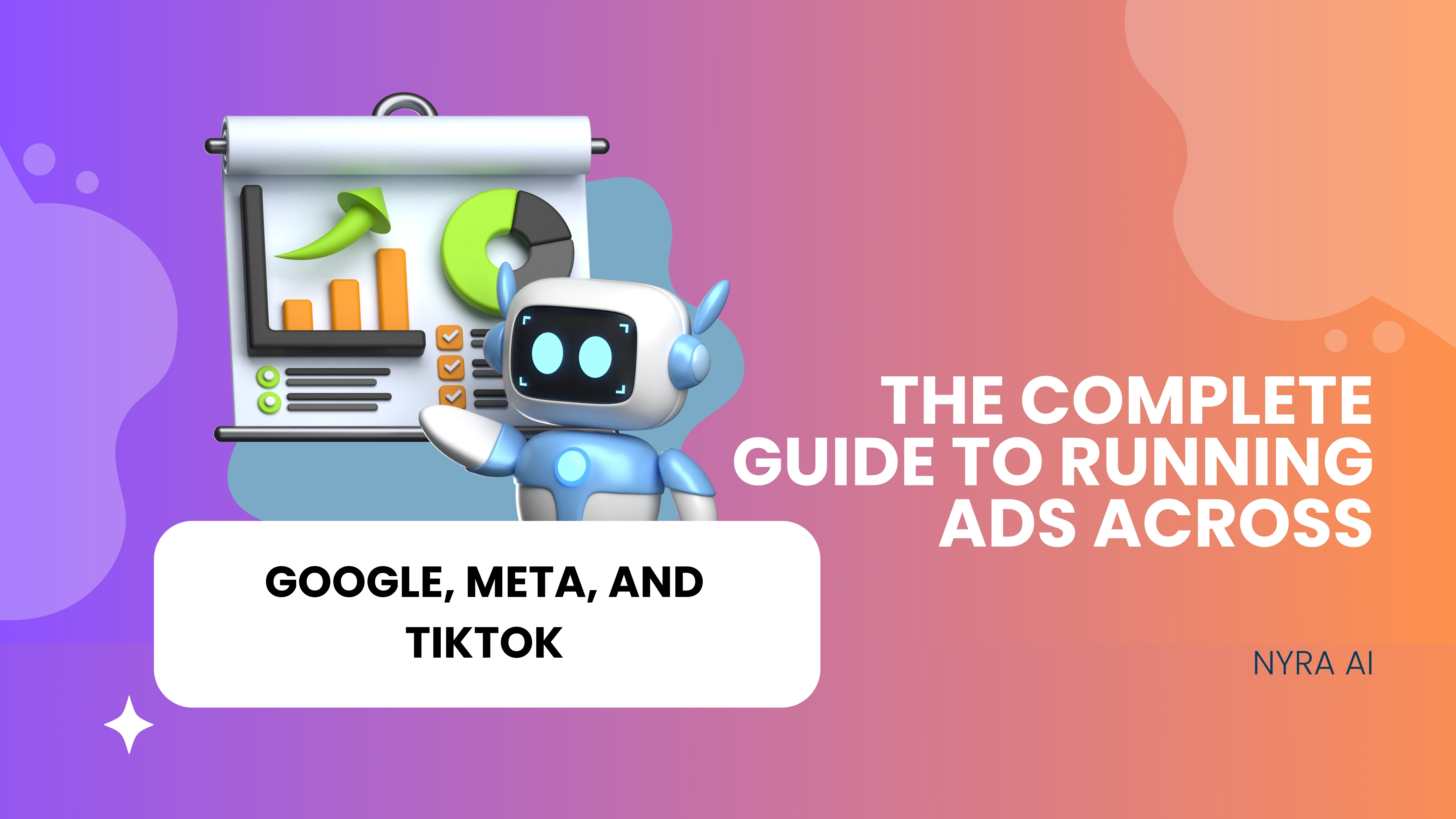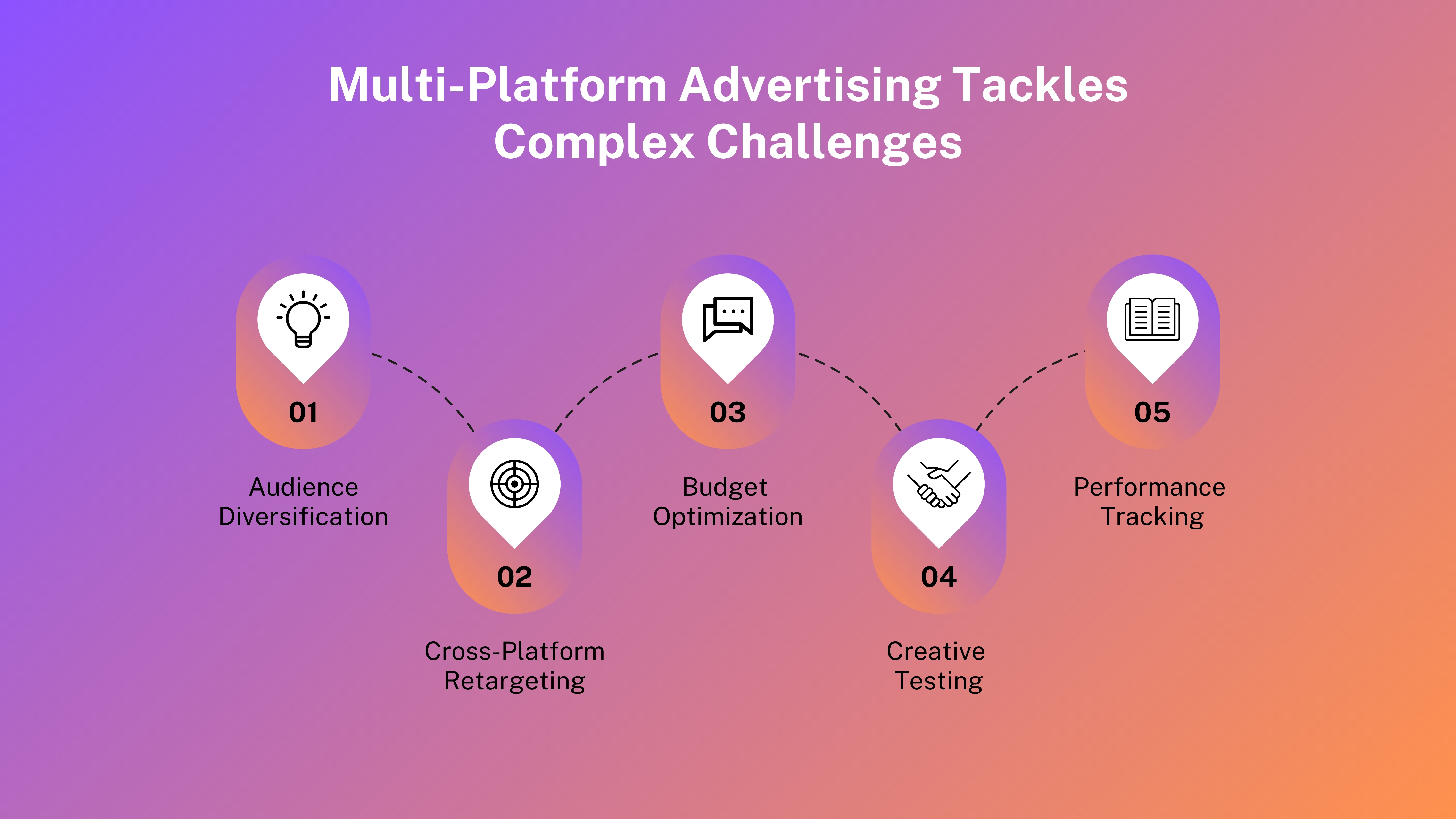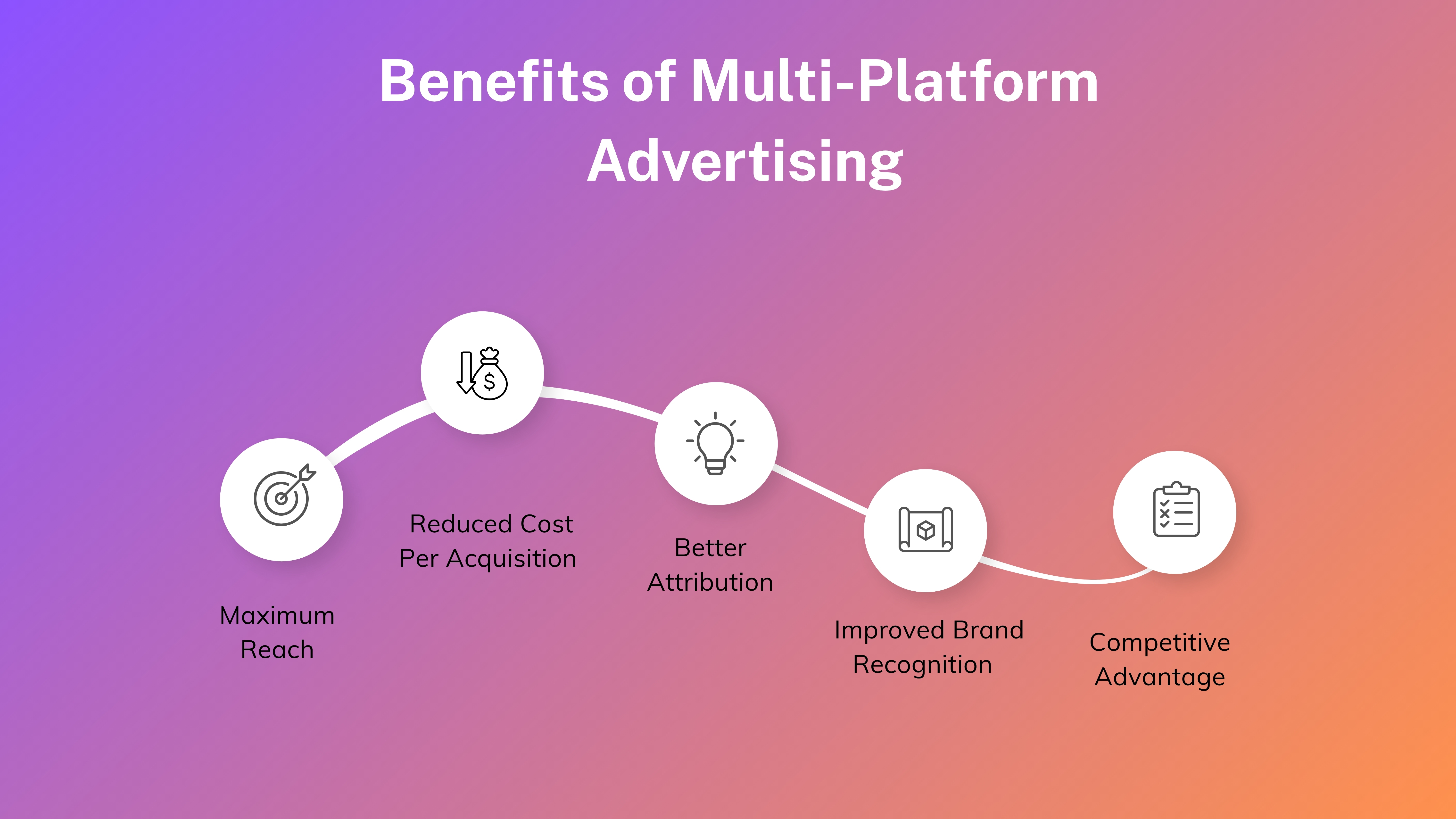The Complete Guide to Running Ads Across Google, Meta, and TikTok

What is Multi-Platform Advertising?
Multi-platform advertising is a strategic approach where businesses run coordinated ad campaigns across multiple digital platforms simultaneously. Instead of putting all your advertising budget into one platform, you diversify across Google, Meta (Facebook and Instagram), and TikTok to reach different audiences at various stages of their customer journey.
Multi-Platform Advertising vs. Single-Platform Campaigns
Single-platform campaigns focus all advertising efforts on one channel, like only running Google Ads or only using Facebook advertising. While this approach allows for deep platform expertise and simplified management, it limits your reach and makes you vulnerable to platform changes, algorithm updates, or increased competition.
How Multi-Platform Advertising Tackles Complex Challenges
Multi-platform advertising solves key marketing obstacles by combining the strengths of each platform to drive better targeting, efficiency, and performance.

-
Audience Diversification ensures you reach customers across different demographics, interests, and behaviors. Google captures high-intent search traffic, Meta connects with social audiences, and TikTok engages younger demographics through entertainment-focused content.
-
Cross-Platform Retargeting allows you to reconnect with potential customers who interacted with your brand on one platform but didn't convert. You can retarget Google searchers on Facebook or reach TikTok viewers through Google Display ads.
-
Budget Optimization becomes more sophisticated when you can shift spending between platforms based on performance. During peak seasons, you might increase TikTok spending while maintaining steady Google Ads for consistent lead generation.
-
Creative Testing across platforms reveals what messaging and formats resonate best with different audiences. A video ad that performs well on TikTok might be adapted for Facebook Stories or YouTube ads.
-
Performance Tracking across platforms provides comprehensive insights into customer behavior and helps identify the most effective touchpoints in your customer journey.
Types of Multi-Platform Campaign Strategies
Before diving into the full breakdown, here’s a preview of the five most effective strategies used in multi-platform advertising:
- Search-Social Integration
- Video-First Approach
- Retargeting Funnels
- Brand Awareness Campaigns
- Performance Max Campaigns
Search-Social Integration
Combines Google's high-intent search traffic with social media's audience targeting. You capture people actively searching for your products while building brand awareness among potential customers who aren't yet ready to buy.
Video-First Approach
Leverages video content across all platforms, adapting the same core message for YouTube ads, Facebook video ads, and TikTok's short-form content to maximize content ROI.
Retargeting Funnels
Create sophisticated customer journeys where users who engage with your content on one platform are retargeted with specific messages on other platforms based on their behavior and interests.
Brand Awareness Campaigns
Use each platform's unique strengths to build comprehensive brand recognition, combining Google's reach with Meta's detailed targeting and TikTok's viral potential.
Performance Max Campaigns
Utilize Google's automated campaign type while running complementary campaigns on Meta and TikTok to capture audiences across the entire digital ecosystem.
How Multi-Platform Advertising Works
Before exploring execution in detail, here’s how each platform plays a specific role in your multi-platform :
- Google Ads Strategy
- Meta Advertising Approach
- TikTok Campaign Execution
- Cross-Platform Coordination
Google Ads Strategy
Focuses on capturing high-intent traffic through search campaigns, reaching users actively looking for your products or services. You run Shopping campaigns for e-commerce, Display campaigns for retargeting, and YouTube ads for video marketing. Google's strength lies in intent-based targeting and immediate conversion opportunities.
Meta Advertising Approach
Leverages Facebook and Instagram's detailed audience targeting and social proof elements. You create awareness campaigns for cold audiences, conversion campaigns for warm leads, and retargeting campaigns for previous website visitors. Meta excels at building relationships and nurturing prospects through the sales funnel.
TikTok Campaign Execution
Capitalizes on the platform's entertainment-focused environment and younger demographics. You create native-feeling content that doesn't interrupt the user experience, utilize trending sounds and hashtags, and leverage TikTok's powerful algorithm for organic reach amplification.
Cross-Platform Coordination
Ensures consistent messaging while adapting to each platform's unique format and audience expectations. You synchronize campaign launches, share audience insights between platforms, and create unified reporting dashboards for comprehensive performance analysis.
Benefits of Multi-Platform Advertising
Running campaigns across multiple platforms unlocks greater reach, efficiency, and performance than relying on a single channel alone.

-
Maximum Reach
Connect with customers across their entire digital journey. While competitors focus on single platforms, you capture attention wherever your audience spends time online. -
Reduced Cost Per Acquisition
Platform diversification and optimization allow you to shift budget to better-performing channels, maintaining efficient customer acquisition costs. -
Better Attribution
Provides clearer insights into customer behavior across touchpoints. You understand which platform initiates interest, which nurtures consideration, and which drives final conversion. -
Improved Brand Recognition
Results from consistent presence across multiple channels. Customers see your brand on Google searches, social media feeds, and entertainment platforms, building trust and familiarity. -
Competitive Advantage
Emerges from sophisticated campaign management that most businesses don't attempt. While others struggle with single-platform optimization, you leverage multiple channels for superior results.
Platform-Specific Advantages
Each platform has unique strengths that make it valuable in a multi-platform ad strategy.
- Google Ads
- Meta (Facebook & Instagram)
- TikTok Ads
Google Ads
Excels at capturing high-intent traffic when people actively search for products or services. It offers precise keyword targeting, immediate visibility for new businesses, and various ad formats including text, shopping, and video ads. Google's vast reach through Search, Display, and YouTube provides comprehensive market coverage.
Meta (Facebook & Instagram)
Provides unmatched audience targeting capabilities using demographic, interest, and behavior data. It excels at building brand awareness, nurturing prospects through detailed remarketing, and leveraging social proof through engagement metrics. The platform's visual formats work exceptionally well for lifestyle and consumer brands.
TikTok Ads
Connects with younger demographics through native, entertainment-focused content. It offers explosive viral potential, lower competition compared to established platforms, and highly engaging short-form video formats. TikTok's algorithm can quickly scale successful campaigns and reach massive audiences organically.
Multi-Platform Advertising Budget Allocation
To get the most out of your campaigns, it's important to plan how you'll distribute and adjust your budget. Here’s a breakdown of the key components:
- Starting Budget Distribution
- Scaling Strategy
- Performance-Based Adjustments
Starting Budget Distribution
Starting budget should reflect each platform’s role in your marketing funnel: Google Ads: 40–50% (High-intent, bottom-funnel) Meta: 35–45% (Awareness and retargeting) TikTok: 10–20% (Experimental and youth targeting)
Scaling Strategy
Involves gradually increasing budgets based on performance metrics and maintaining consistent cost-per-acquisition targets. Successful campaigns receive additional funding while underperforming ones get optimized or paused.
Performance-Based Adjustments
Allow you to shift budgets between platforms based on seasonal trends, campaign performance, and competitive landscape changes. This flexibility maximizes ROI and maintains efficient customer acquisition.
Multi-Platform Advertising FAQ
Q: How much budget do I need for multi-platform advertising?
A: Start with at least ₹2.5–4 lakhs ($3,000–5,000) per month spread across platforms. This provides enough data for optimization while allowing meaningful budget allocation to each channel.
Q: Which platforms should I prioritize?
A: Google Ads for immediate results and high-intent traffic, Meta for audience building and retargeting, TikTok for reaching younger demographics and viral potential.
Q: How do I measure cross-platform success?
A: Use Google Analytics 4 for comprehensive tracking, platform-specific attribution reports, and customer lifetime value analysis. Focus on overall business metrics rather than individual platform performance.
Q: Should I use the same creative across all platforms?
A: No. Adapt your core message to each platform’s format and audience expectations. TikTok needs native, entertainment-focused content while Google Ads requires clear, conversion-focused messaging.
Q: How long before I see results?
A: Google Ads can show results within days, Meta typically requires 2–4 weeks for optimization, and TikTok may take 4–6 weeks to gain traction. Full multi-platform optimization usually takes 2–3 months.